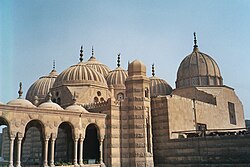Hosh al-Basha
| Hosh al-Basha | |
|---|---|
 | |
| Location | Fustat, Southern Cemetery[disambiguation needed], Cairo, Egypt |
| Coordinates | 30°00′43″N 31°15′26″E / 30.012069°N 31.257277°E |
| Built | A.D.1854 / 1271 A.H. |
| Built for | Muhammad Ali dynasty |
| Architectural style(s) | Ottoman architecture |
Hosh al-Basha (Template:Lang-ar - Hawsh Al Basha), also Hosh el Basha or Hoch el Pacha, meaning "Courtyard of The Sir")[1], is a mausoleum of the Royal Family of Muhammad Ali Pasha at road al-Imam Al-Shafi‘i in Fustat, Southern Cemetery[disambiguation needed][2] of the Mamluk Necropoli in Cairo, Egypt.
Description
Hosh al-Pasha was built in 1854 to house several tombs of the Muhammad Ali dynasty’s family, relatives, and devoted servants.[3] The structure is a six-domed complex with inner courtyards and chambers heavily decorated by Islamic motifs, colors and precious materials that still show much of the original luxurious and rich state of the place[4]
Some of the royals buried in Hosh al-Basha: Ibrahim Pasha of Egypt, Tusun Pasha, Ismail Pasha, Sa'id of Egypt, Abbas I of Egypt, Ahmad Rifaat Pasha and his daughter Ayn-al-Hayat Rifaat and Mohammed Ali Tewfik.
-
Hosh al-Basha From Al Iman Al Shafai Road.
-
Inner Courtyard of Hosh al-Basha.
-
Hosh al-Basha Internal Courtyard's Gallery.
-
One of The Chambers of Hosth al-Basha.
-
Tombs of Hosh al-Basha.
-
Tombs of Hosh al-Basha.
-
Qobbat al-Basha (Dome of The Basha).
-
Grand Tomb inside the Complex.
-
The Domes of The Funerary Complex of Hosh al-Basha, front the roof.
Bibliography
- Williams, Caroline, "Islamic Monuments in Cairo: The Practical Guide", American University of Cairo Press, 2008, 214 pages.
- Richard Bordeaux Parker, "Islamic Monuments in Cairo: A Practical Guide", American University in Cairo Press. 1993, 312 pages.
See also
References
Notes
- ^ https://www.egypttoday.com/Article/4/49806/Hosh-al-Basha-at-El-Imam-El-Shafei-to-be
- ^ El Kadi, Galila; Bonnamy, Alain (2007). Architecture for the Dead: Cairo's Medieval Necropolis. Cairo: The American University in Cairo Press.
- ^ Williams, Caroline, Islamic Monuments in Cairo: The Practical Guide. Cairo: American University of Cairo Press, 2008, pag 135 of 2014.
- ^ Williams, Caroline, Islamic Monuments in Cairo: The Practical Guide. Cairo: American University of Cairo Press, 2008, page 135 of 214.
External links
- Hosh El Basha : Egypt's Royal Cemetery, https://www.youtube.com/watch?v=9ZFbaQAC5fg
- Hosh al-Basha, https://www.alamy.com/stock-photo-hosh-al-basha-or-hosh-el-basha-funerary-complex-southern-cemetery-131052249.html?pv=1&stamp=2&imageid=BC2793B7-5B96-4F5E-A45C-81AE53E3A111&p=63192&n=0&orientation=0&pn=1&searchtype=0&IsFromSearch=1&srch=foo%3dbar%26st%3d0%26pn%3d1%26ps%3d100%26sortby%3d2%26resultview%3dsortbyPopular%26npgs%3d0%26qt%3dsouthern%2520cemetery%26qt_raw%3dsouthern%2520cemetery%26lic%3d3%26mr%3d0%26pr%3d0%26ot%3d0%26creative%3d%26ag%3d0%26hc%3d0%26pc%3d%26blackwhite%3d%26cutout%3d%26tbar%3d1%26et%3d0x000000000000000000000%26vp%3d0%26loc%3d0%26imgt%3d0%26dtfr%3d%26dtto%3d%26size%3d0xFF%26archive%3d1%26groupid%3d%26pseudoid%3d%26a%3d%26cdid%3d%26cdsrt%3d%26name%3d%26qn%3d%26apalib%3d%26apalic%3d%26lightbox%3d%26gname%3d%26gtype%3d%26xstx%3d0%26simid%3d%26saveQry%3d%26editorial%3d1%26nu%3d%26t%3d%26edoptin%3d%26customgeoip%3d%26cap%3d1%26cbstore%3d1%26vd%3d0%26lb%3d%26fi%3d2%26edrf%3d%26ispremium%3d1%26flip%3d0%26pl%3d
- Jumping from dome to dome in Hosh al-Basha, November 08, 2014, https://astrid-scheuermann.squarespace.com/spiegeleye/2014/11/jumping-from-dome-to-dome-in-hosh-al.html
- MOHAMED ALI` TOMBS (HOSH EL BASHA), Architectural Heritage of Egypt, https://www.facebook.com/pg/ArchitecturalHeritageOfEgypt/photos/?tab=album&album_id=397625516975790
- The Muhammad 'Ali Dynasty GENEALOGY, https://www.royalark.net/Egypt/egypt5.htm
- RULERS OF EGYPT FROM THE HOUSE OF MOHAMMED ALY https://web.archive.org/web/20080516115029/http://www.egy.com/P/royal/royaltree.html










